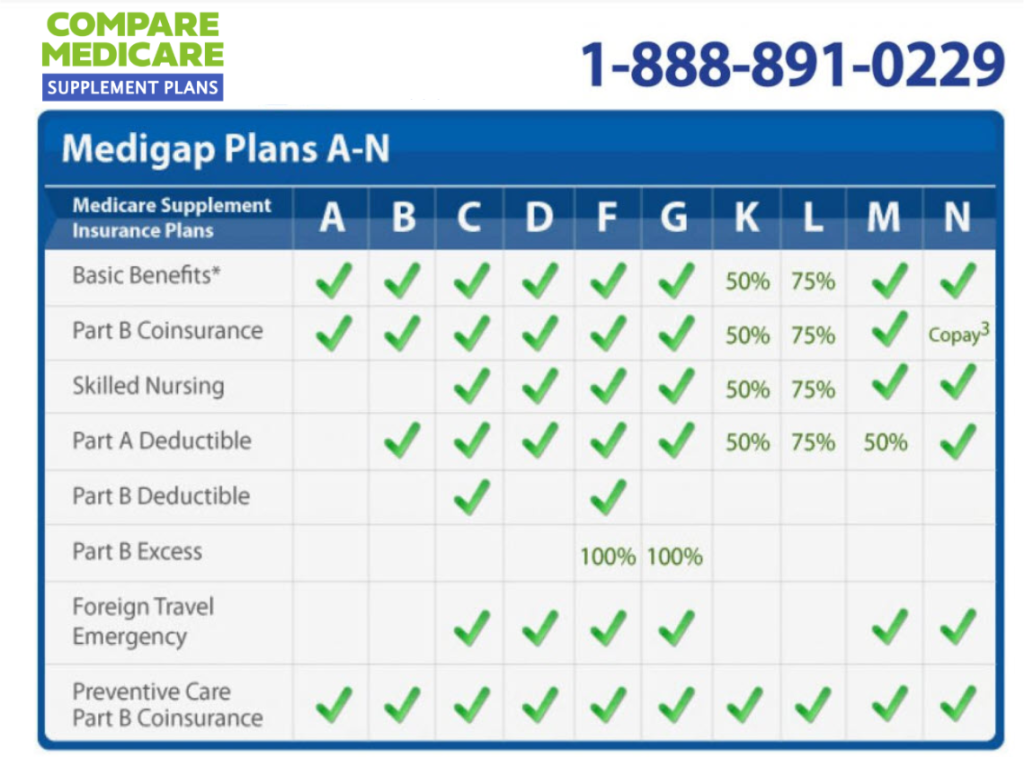Medigap Plans 2024
If you’re planning on enrolling in Medicare, making sure that you have the coverage you need is essential.
Medigap plans can help to cover the out-of-pocket medical expenses that Medicare doesn’t cover.
There are several types of Medigap plans available, which is a good thing, but with so many options to choose from, trying to decide which plan will best suit your needs can seem like a daunting experience.
To help make things less overwhelming, we’ve narrowed down the options to what we think are the best Medigap plans for 2024.

What Are Medigap Plans
Medigap, formally known as Medicare Supplement Insurance, is additional insurance that pays for the gaps in Original Medicare coverage; both Part A (inpatient care) and Part B (outpatient care).
Medigap plans can help to pay for things like deductibles, copayments, and coinsurance.
Medigap policies are sold by private health insurance companies.
There are several different plans available that are named after specific letters.
Different lettered plans offer different benefits, but because all Medicare Supplement Insurance plans are standardized, all policies of the same letter must offer the same Medicare-approved benefits; for example, all Plan G policies must provide the same Medicare-approved benefits.
With that said, however, health insurance companies can offer additional benefits for specific plans on top of the required benefits.
Compare Plans & Rates
Enter Zip Code
Best Medigap Plans for 2024
There are a total of 10 Medicare Supplement Insurance plans: A, B, C, D, F, G, K, L, M, and N.
Of these policies, Plan G, N, and F are the best options for 2024, as they offer the most comprehensive coverage.

Medigap Plan F
Of all the different Medicare Supplement Insurance options, Medigap Plan F offers the most comprehensive coverage.
It’s important to note, however, that unless you were eligible for Medicare before January 1, 2020, you will not be able to purchase Plan F.
 In other words, new Medicare enrollees cannot enroll in this Medigap plan.
In other words, new Medicare enrollees cannot enroll in this Medigap plan.
If, however, you were a Medicare beneficiary prior to the start of 2020 and you already had Plan F, you can maintain your coverage.
Also, if you were eligible for Medicare before January 1, 2020 but you waited to enroll, you may be able to purchase Plan F.
What Does Plan F Cover?
Medigap Plan F covers most of the out-of-pocket expenses that Original Medicare doesn’t pay for, including:
- Part A deductible
- Part A hospice care copayment or coinsurance
- Part A coinsurance and hospital care (as much as an extra 365 days past when your Part A benefits were exhausted)
- Part B deductible
- Part B coinsurance or copayment
- Part B excess charges
- Coinsurance for skilled nursing facility care
- First three pints for blood transfusions
- Emergency medical care received within the first 60 days of traveling outside of the United States
Medigap Plan G
 For new Medicare enrollees who aren’t eligible for Medigap Plan F but would like to invest in a supplemental policy that offers as much coverage for out-of-pocket expenses as possible, Medigap Plan G is a good alternative.
For new Medicare enrollees who aren’t eligible for Medigap Plan F but would like to invest in a supplemental policy that offers as much coverage for out-of-pocket expenses as possible, Medigap Plan G is a good alternative.
What Does Plan G Cover?
Medigap Plan G offers the most comprehensive coverage for newly enrolled Medicare beneficiaries.
With the exception of the Part B deductible, it offers all the same benefits as Plan G:
- Part A deductible
- Part A hospice care copayment or coinsurance
- Part A coinsurance and hospital care (as much as an extra 365 days past when your Part A benefits were exhausted)
- Part B coinsurance or copayment
- Part B excess charges
- Coinsurance for skilled nursing facility care
- First three pints for blood transfusions
- Emergency medical care received within the first 60 days of traveling outside of the United States
Medigap Plan N
 If you don’t expect that you’re going to need a lot of medical care, yet you want to have coverage for the out-of-pocket expenses that Original Medicare doesn’t cover, Medigap Plan N may be the right choice for you.
If you don’t expect that you’re going to need a lot of medical care, yet you want to have coverage for the out-of-pocket expenses that Original Medicare doesn’t cover, Medigap Plan N may be the right choice for you.
This plan is more cost-effective than Plan F and Plan G, as the premiums are lower; however, the copays are higher.
What Does Plan N Cover?
Medigap Plan N offers many of the same benefits as Plan F and Plan G, but not all benefits are the same.
Additionally, as noted above, the copays are higher, but that’s what makes the premiums lower. Benefits for Plan N include the following:
- Part A deductible
- Part A hospice care copayment or coinsurance
- Part A coinsurance and hospital care (as much as an extra 365 days past when your Part A benefits were exhausted)
- Part B coinsurance, with copayments of up to $20 for each office visit and up to %50 for ER visits.
- Coinsurance for skilled nursing facility care
- First three pints for blood transfusions
- Emergency medical care is received within the first 60 days of traveling outside of the United States.
How Much Do Medigap Plans Cost in 2024?
The cost for Medicare Supplement Insurance plans varies from plan to plan and insurer to insurer.
Insurance companies set the premiums for the plans they offer, and there are several factors that they take into consideration when determining the rates they charge.
These factors can include:
- Age
- Geographic location
- Gender
- Medical history (if you enroll outside of the Medicare Open Enrollment period)
- Inflation
How to Enroll
In order to enroll for a Medicare Supplement Insurance Plan, you must be enrolled in Original Medicare.
You can purchase a Medigap policy through a private insurance company that sells the policy you are interested in.
 The best time to enroll is during the Medicare Open Enrollment period, which starts on the first day of the month that you turn 65 and lasts for 6 months.
The best time to enroll is during the Medicare Open Enrollment period, which starts on the first day of the month that you turn 65 and lasts for 6 months.
During this period, you are guaranteed acceptance, as insurance companies cannot consider:
- your health;
- however, after this period, the price and your eligibility for the Medigap policy you’re interested in may be impacted, as insurers can take your medical history into consideration.
Frequently Asked Questions
What are Medigap Plans?
Medigap Plans, also known as Medicare Supplement Plans, are private health insurance policies that help cover the gaps in Original Medicare, such as deductibles, copayments, and coinsurance.
How do Medigap Plans work?
Medigap Plans work alongside Original Medicare. They pay for some or all of the costs that Medicare doesn’t cover, depending on the specific plan you choose. This can include expenses like hospital stays, doctor visits, and certain medical services.
When can I enroll in a Medigap Plan?
The best time to enroll in a Medigap Plan is during your Medigap Open Enrollment Period. This period begins when you’re 65 or older and enrolled in Medicare Part B.
It lasts for six months, and during this time, you have guaranteed issue rights, meaning insurers cannot deny you coverage or charge higher premiums due to pre-existing conditions.
How many Medigap Plans are available?
In most states, there are 10 standardized Medigap Plans, labeled A, B, C, D, F, G, K, L, M, and N. Each plan offers a different set of benefits, although Plan F and Plan C are no longer available to newly eligible Medicare beneficiaries as of 2020.
Are Medigap Plans the same as Medicare Advantage Plans?
No, Medigap Plans and Medicare Advantage Plans are different.
Medigap Plans work with Original Medicare, while Medicare Advantage Plans are an alternative to Original Medicare.
Medicare Advantage Plans often include prescription drug coverage and may offer additional benefits beyond what Original Medicare provides.
How much do Medigap Plans cost?
The cost of Medigap Plans can vary depending on several factors, including your location, age, gender, and the specific plan you choose. Insurance companies determine the premiums, so it’s essential to compare prices from different providers to find the best option for your needs.
Can I switch Medigap Plans?
Yes, you can switch Medigap Plans at any time. However, if you’ve had your Medigap Plan for less than six months, you may be subject to medical underwriting, which means the insurance company can consider your health status when determining your premiums or coverage.
Do Medigap Plans cover prescription drugs?
No, Medigap Plans do not cover prescription drugs. If you want prescription drug coverage, you’ll need to enroll in a separate Medicare Part D prescription drug plan.
Are pre-existing conditions covered under Medigap Plans?
During your Medigap Open Enrollment Period, insurers cannot deny you coverage or charge higher premiums due to pre-existing conditions. However, if you apply for a Medigap Plan outside of this period, the insurer may consider your health status and impose waiting periods or higher premiums.
Can I use my Medigap Plan outside of the United States?
Some Medigap Plans provide limited coverage for foreign travel emergencies, but it’s important to check the specific details of your plan. If you frequently travel outside the U.S. and need broader coverage, you may want to consider a travel medical insurance policy.
How to Compare Medigap Plans
When trying to decide which Medicare Supplement Insurance plan will work best for you, it’s important to consider your healthcare needs and your budget.
It’s also a wise idea to compare quotes from several different providers.
To start receiving and comparing quotes from credible insurance companies, fill out the form to the right or call 1-888-891-0229 and one of our agents will be happy to assist you.

Updated December 4th, 2022

